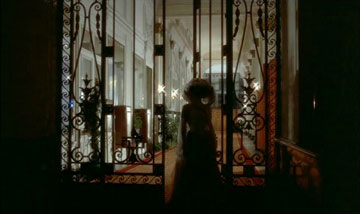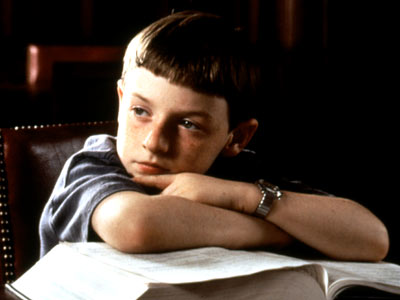From the Chicago Reader (May 1, 1989). — J.R.

Alain Resnais’ comeback in 1974 after five years’ absence (precipitated by the commercial failure of Je t’aime, je t’aime), and like many other of his films, it has improved with age. Scripted by Jorge Semprun (La guerre est finie, Z), it tells the true story of a notorious international financier (Jean-Paul Belmondo) whose ruin in 1933 led to a major political scandal and his own death. While the script isn’t always lucid — some attempts to counterpoint Stavisky’s destiny with that of Leon Trotsky, given political asylum in France during the time of the events covered, appear a bit forced — the power of Resnais’ evocative editing is as strong as ever. Using a gorgeous original score by Stephen Sondheim, elegant sets and locations, and beautiful color cinematography by Sacha Vierny, Resnais models his liquid, bittersweet style on Lubitsch, and the shimmering, romantic results are often spellbinding and haunting. With Anny Duperey, Charles Boyer (in what may be his last great screen performance), Michel Lonsdale, Francois Perier, Claude Rich, and, in an early cameo, Gerard Depardieu. (JR)
 Read more
Read more
From the Chicago Reader (October 25, 1991). — J.R.

LITTLE MAN TATE
*** (A must-see)
Directed by Jodie Foster
Written by Scott Frank
With Adam Hann-Byrd, Jodie Foster, Dianne Wiest, Harry Connick Jr., David Pierce, Debi Mazar, and P.J. Ochlan.

Part of what’s refreshing about Jodie Foster’s first feature as a director is its quirky style and vision; even the picture’s limitations have a certain offbeat integrity. In 90 percent of the movies we see the flaws are the same old flaws endlessly recycled (inherited like family curses, passed along like viruses): sentimentality, cliched characters and behavior, and stock attitudes, camera placements, and audience manipulations. Relatively free of these familiar blemishes, Little Man Tate winds up with a few of its own — “missing pieces” might be more accurate — but most of these problems seem to have been arrived at honestly rather than automatically imported from other movies.
The title hero is a boy genius named Fred (Adam Hann-Byrd) who occasionally narrates his own story, which transpires mainly between his seventh and eighth birthdays. He’s gifted in so many ways that, at least on the schematic level of Scott Frank’s script, he often seems like several boy geniuses jammed together: a self-taught reader by age one, he also quickly reveals himself to be a talented visual artist, a remarkable classical pianist, an original and accomplished poet, and a mathematical wizard who breezes through a college course in quantum physics when he’s seven. Read more
From Monthly Film Bulletin, July 1976 (Vol. 43, No. 510). — J.R.

Mes Petites Amoureuses
France, 1975
Director: Jean Eustache

Southwest France, circa 1950. Daniel, a schoolboy living with his grandmother, recalls hitting a schoolmate gratuitously, and getting his first erection as a candle-bearer during Mass. Impressed by a sword-swallower in a circus who lies down on broken glass, he duplicates this feat with artifice and fake blood to impress his friends, but later is overcome by a local girl who forces him to the ground and sits on hirn. After he has passed his entrance exams, his mother arrives on a visit with her lover José, a Spanish labourer. Eventually he moves to the city to join his mother and José, but the former forbids him to attend school and has him work without pay as an apprentice to Henri, José’s brother, at a bike repair shop. Spending much of his time looking at women, he goes to see Pandora and the Flying Dutchman at a local cinema where, imitating another boy in the audience, he kisses and caresses a girl seated in front of him, but then leaves the film before it is over. He frequents the local Bar des Quatre Fontaines, where he observes his more amorously active friends, and also attends a local fair where he feels the leg of a girl in the crowd while they listen to the singing of other girls from the nearby convent of St. Read more






